Factors affecting wine texture, taste, clarity, stability and production efficiency
Project summary
Wine texture is considered a major product differentiator both for wine style and value in the marketplace. In addition, clarity and colour stability (absence of haze development and the retention of colour) are generally considered essential for market success. Achieving desired textural qualities, clarity and stability can involve processing steps with significant costs. The ability to modulate these characteristics of wine while maintaining profitability is a significant challenge for the wine industry. This project aims to elucidate key compositional drivers of texture, bitterness, clarity, stability (protein and colour) and wine filterability, and seeks to develop strategies to modulate them in a production- based environment. This research will provide knowledge of grape and wine composition for polyphenols, polysaccharides and proteins and a clearer understanding of the impact of winemaking processes on macromolecule concentrations and colloidal profiles.
The following specific aspects are being investigated in this project:
- the compositional drivers of texture, hotness and bitterness
- the role of macromolecules such as tannins, polysaccharides, proteins and their aggregate colloids in the expression of texture, stability, clarity and filterability
- the impact of other wine matrix components on macromolecule function and expression
- the source of these molecules or their precursors in grapes and yeast and the impact of winemaking processes such as clarification, flotation, vinification and filtration on their retention and/or transformation
- the impact of filtration on macromolecules
- strategies for modulation of specific compositional drivers through the use of grape-based fining agents
- alternative strategies for achieving protein stability
- practical methods for wineries to determine likely extractability of macromolecules during winemaking
- strategies for the stabilisation of colour independent of vintage effects.
The knowledge generated by the project will provide a framework for the development of winemaking strategies, practical tools and recommendations for managing colour (and colour stability), astringency, viscosity, hotness, bitterness, filtration processes and protein hazes.
Latest information
Impact of juice clarification on macromolecules and phenolics in white wine
Making wine from juices that contain grape solids is becoming a popular option amongst producers of fuller bodied white wine styles, as the practice improves fermentation kinetics and may also result in more ‘textural’ and complex wines. Previous research using laboratory-scale ferments revealed that wines produced from less clarified juices contained significantly higher concentrations of total polysaccharides, which could mostly be attributed to higher levels of mannoproteins. In 2015, a vintage experiment was conducted to further assess the effect of juice clarity on wine composition, but due to the larger scale of the trial, flavour and mouth-feel could also be determined. High and low solids Sauvignon Blanc and Chardonnay juices were produced by medium-sized wineries using typical crushing, draining and enzyme-assisted settling methods, and these juices were vinified under experimental conditions.
Higher juice solids content resulted in wines that were slightly more viscous, bitter and hot and these characteristics were most consistently associated with wine phenolic concentration and composition. Fermenting on solids resulted in wines with higher concentrations of esters, fatty acids, higher alcohols and (notably) thiols. In the case of Sauvignon Blanc, the fourfold increase in volatile thiol concentration in the wines produced by fermenting on solids was seen in significantly higher ‘passionfruit’ and ‘flinty’ characters.
Evaluation of the effects of juice solids content on wine composition and mouth-feel continued in vintage 2016 through a winery trial where juice clarity was achieved by the widely used method of flotation. Analysis of the wine from that trial is under way.
Molecular drivers of texture and taste
The perceived bitterness of 24 white wine fractions of varying hydrophobicity was previously modelled on their non-volatile composition using non-targeted analysis. A compound identified as an amino acid derivative by interpretation of its MS-MS spectrum was associated with the perceived bitterness of a number of fractions. A method of purifying this compound has been developed and sensory analysis to assess its potential for eliciting bitterness is scheduled.
Novel protein stabilisation strategies
A novel magnetic separation technology that allows for selective removal of pathogenesis-related proteins from wines was developed. Magnetic nanoparticles (MNPs) have previously been used in biotechnology to separate products or immobilised enzymes from reaction mixtures and to separate cells and microorganisms, including yeast. The aim of this research was to develop a rapid and selective method to separate pathogenesis-related proteins from unfined white wines. It was hypothesised that careful tuning of the surface functionality of magnetic particles could be used to selectively capture pathogenesis-related proteins from wines which could then be separated from the system by applying an external magnetic force. For protein haze removal, carefully controlled functional groups coated onto magnetic particles were used to bind protein molecules. Figure 3A presents a schematic of the magnetic separation process. In the first step of the process magnetic beads were coated by plasma deposition of acrylic acid vapour to generate COOH-rich surfaces. This coating was selected based on previous work investigating wine absorption onto different surfaces. The second step of the process involved adding the coated magnetic nanoparticles to white wines. The final step was a simple separation of the particles from wine using an external magnet.
Nine different unfined wines with varied protein concentrations (from 10 to 400 mg/L) were tested. Figure 3B shows the concentrations of thaumatin-like proteins and chitinases in a Verdejo wine after removal with coated MNPs compared to an untreated control. Treated white wines were analysed for protein and phenolic content to assess the performance of the functionalised surface. It was found that the surface was able to selectively bind pathogenesis-related proteins from wines and hence form stable wines without affecting phenolic content.
Investigation of proteases with potential to degrade haze-forming proteins also continued during the year. The main protease studied was BcAP8, an enzyme from Botrytis cinerea that has shown some promise in small-scale trials. Sufficient quantities of the enzyme were produced from Pichia yeast cultures but in all cases, the haze formed in the heat test increased with BcAP8 addition, which indicates that this protease is not as promising as first thought. Protein stability through use of enzymes is better achieved using a combination of aspergillopepsin (AGP) enzyme with flash pasteurisation, as previously reported.
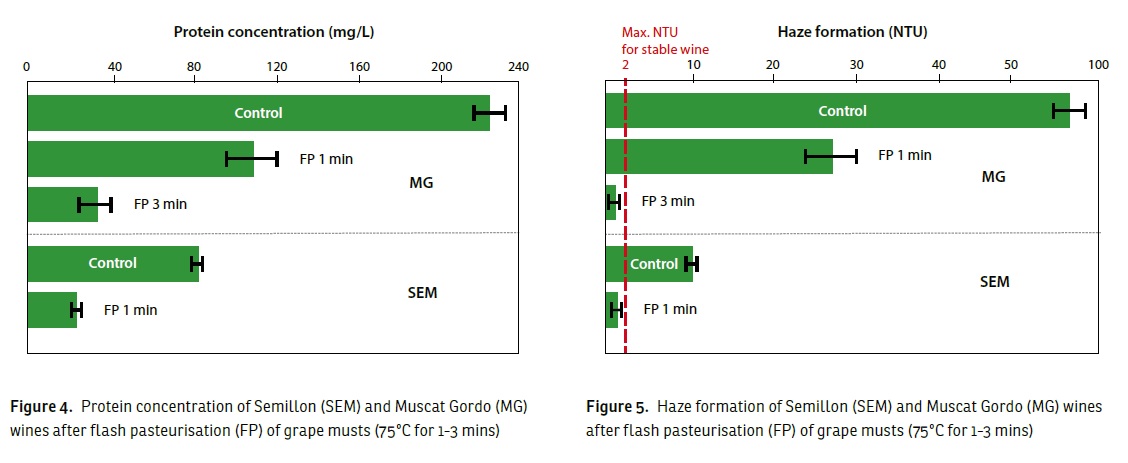
Trials of flash pasteurisation alone (without AGP enzyme) were also investigated as an alternative stabilisation strategy (Figure4 and Figure 5). Heating grape juice for one minute at 75°C was sufficient to produce stable Semillon and Sauvignon Blanc wines. The higher protein concentration of the Muscat Gordo required three minutes of heating to produce stable wine. Therefore, pasteurisation for one to three minutes maybe sufficient to stabilise wines and maybe a viable alternative stabilisation strategy for the wine industry. The protease and pasteurisation results have been submitted for publication.
The use of flash pasteurisation in industry is not always possible and therefore alternative protein unfolding strategies were also investigated. A vortex fluidic device (VFD) uses sheer force instead of elevated temperature to unfold proteins and has proven to be effective for unfolding and refolding some proteins. When used in grape juice though, there was no change in protein concentration in the treated and untreated grape musts. This suggested that unfolding had not occurred because unfolding would cause precipitation and hence a change in soluble protein concentration.
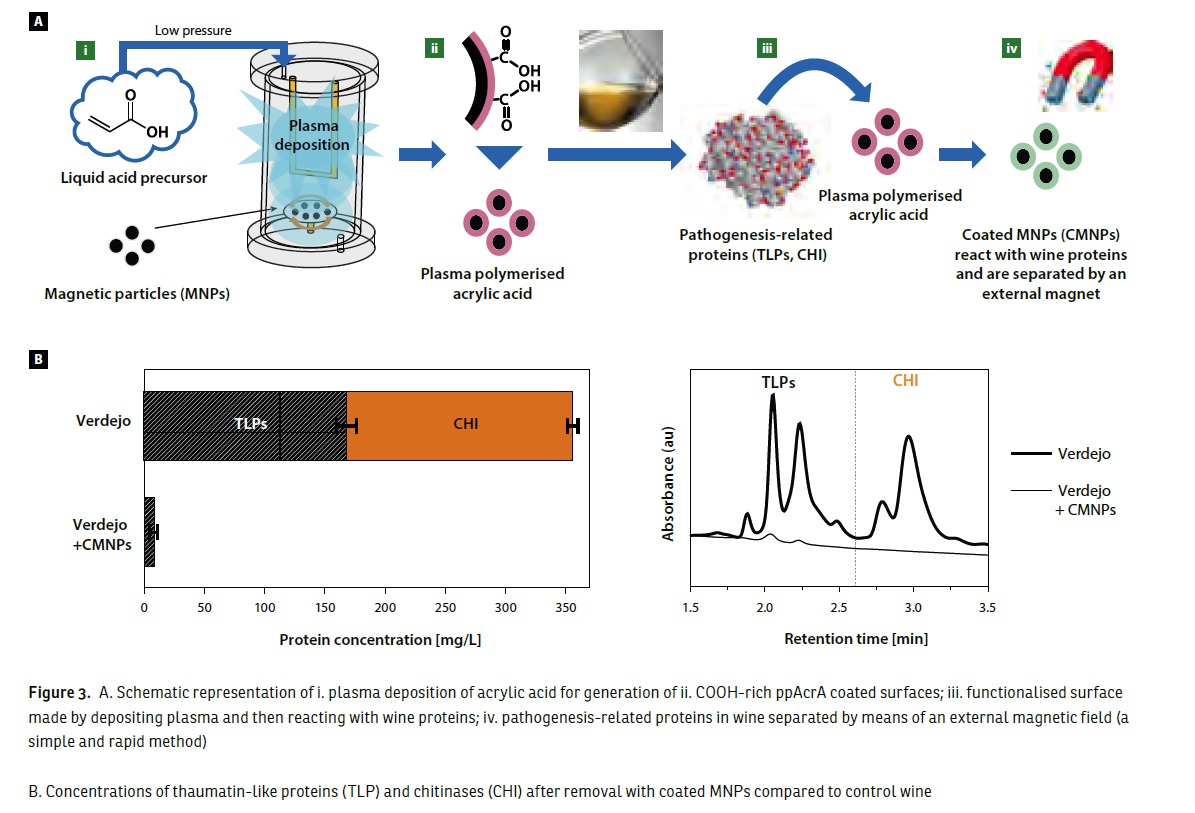
Carrageenan (a food-grade polysaccharide) is another potentially viable bentonite alternative for protein stabilisation of wine. Concerns have been raised in the past about the impact of this product on filtration. A trial was established in collaboration with industry partner, Treasury Wine Estates, to investigate the use of different settling agents and filtration aids following carrageenan use. The results of these trials will provide additional knowledge about the potential of carrageenan as a bentonite alternative.
Matrix effects on protein haze formation
The impact of matrix components (ionic strength, phenolic compounds, polysaccharides, sulfate) on the stability of chitinase proteins was investigated using nanoparticle tracking analysis (NTA). This study examined, via reconstitution experiments, the aggregation behaviour of purified chitinases and measured the size and concentration of individual particles formed by this protein before and after heating in the presence or absence of wine phenolics and/or polysaccharides and/or sulfates. The role played by ionic strength and sulfate in the aggregation of chitinases was also assessed. The study confirmed that protein haze formation in white wine is a multifactorial process where ionic strength, sulfate, phenolic compounds and polysaccharides all modulate the haze potential.
In addition, the strength of interactions between proteins and polysaccharides was assessed using isothermal titration calorimetry (ITC). When proteins were in their native state, there were limited interactions between these macromolecules. However, when proteins were unfolded, such as after heat exposure, there were weak interactions between proteins and polysaccharides. Investigation of the impact on particle formation is under way.
The influence of matrix parameters on protein stability was measured in multifactorial experiments conducted in collaboration with CSIRO. This involved exploring the influence of pH, ethanol, and salts on stability of four proteins. The results indicated that ethanol did not affect protein stability, however pH played a major role. This provides further evidence about the complexity of wine interactions and haze formation.
Impacts of filtration on wine macromolecules
Red wines (Cabernet Sauvignon and Shiraz from the 2013 and 2014 vintages) were filtered through winery-scale commercial filters in sequence, including crossflow, lenticulars, 0.65 µm and 0.45 µm membranes, with samples taken before and after each filtration grade. Macromolecules and colour parameters were measured within a few weeks of bottling, after 9 months’ ageing and after 18 months’ ageing. Chemical analysis indicated no change in the tannin, colour, polysaccharide concentration or composition with any grade of filtration. However, particle size did decrease with crossflow filtration (Figure 6). This was due to the removal of pre-formed complexes of tannin/protein/polysaccharides as well as residual microbes.
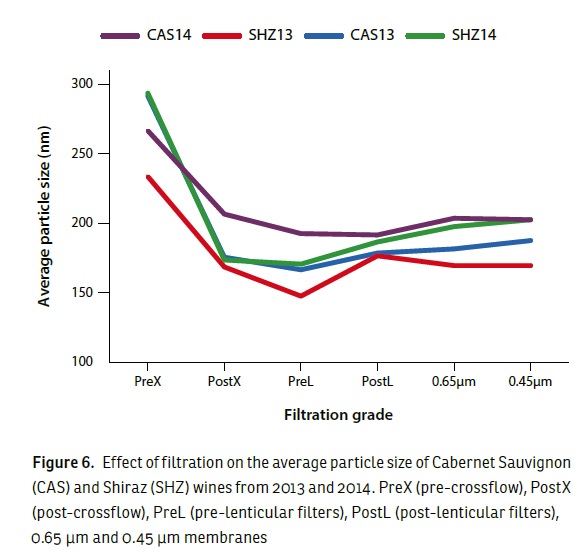
After 18 months of ageing, the particle size of the 2013 wines increased in all wine samples at all filtration grades. This trend was not observed in the 2014 wines. The reason for the difference in filtration recovery between the 2013 and 2014 wines is not clear and will be explored in future research.
Sensory analysis was undertaken on the pre-crossflow, post-crossflow and post-0.45 µm wines (Figure 7). There was no significant filtration-related difference in mouth-feel between samples. This suggested that winery-scale filtration does not significantly change wine macromolecules or mouth-feel but does remove the microbes associated with spoilage.
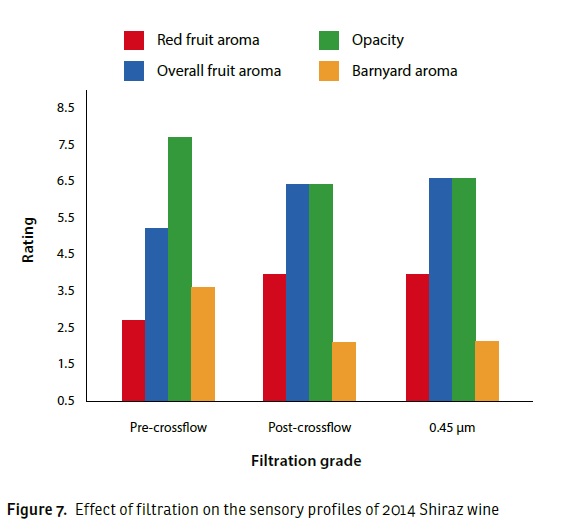
Development of a predictive model for determining white wine haze risk
To assess the potential for creating a predictive model for haze formation, over 100 protein-unstable 2015 vintage wines were sourced from industry partners including Kingston Estate, Treasury Wine Estates, Pernod Ricard Winemakers and Yalumba. These wines were analysed for compositional parameters of the matrix as well as protein concentration and composition. These parameters were then compared to the haze produced in a heat test. The strongest correlation with haze formation was the protein concentration, which suggests that predicting haze is best achieved with a heat test rather than through testing those particular compositional parameters.
The current heat test used in industry is both time-consuming and variable. Because of this, effort is being invested in creating a new heat test for industry that is more rapid and accurate. Preliminary trials assessed the impact of heating time and cooling time and temperature on haze formation. Longer heating and longer cooling times at lower temperature produced greater haze but it was uncertain how this affected the bentonite fining rate. A range of unstable wines from the 2016 vintage were obtained from Yalumba. Wines were fined at the bentonite concentrations predicted by different heat tests and have been stored at different temperatures to assess haze formation after 12 months’ storage. The results of these trials will ultimately be used to refine the current heat test to be a more efficient measurement for the wine industry.
Macromolecule and colour extraction, stability and retention – influence on wine style and production practice
This project aims to understand how macromolecules are influenced by winemaking techniques, their relative stability and size in solution and how this ultimately affects wine production processes and texture. A range of maceration techniques were applied to determine their relative impact on the extraction of tannin, polysaccharide and colour. The techniques applied either alone or in combination were: microwave maceration, macerating enzyme, extended maceration, yeast selection and marc addition. Large differences in tannin, colour and polysaccharide concentration were achieved using these diverse maceration approaches.
For the study of microwave maceration, and other maceration techniques to improve macromolecule extraction in Pinot Noir, collaboration with Dr Anna Carew and Dr Fiona Kerslake (Tasmanian Institute of Agriculture) continued. For multiple Pinot Noir fruit sources, microwave maceration was found to be more successful in the extraction of tannin and anthocyanin and the development of stable colour than other maceration techniques. These microwave-macerated wines were also of interest in the study of colloid formation and stability using NTA (Figure 8) (Bindon et al. 2016a). The application of microwave maceration increased the concentration of wine protein, polysaccharide and tannin, leading to increases in total particle concentration. There was no effect of microwave maceration on particle size, suggesting that the complexes formed were stable (≈ 200 nm).
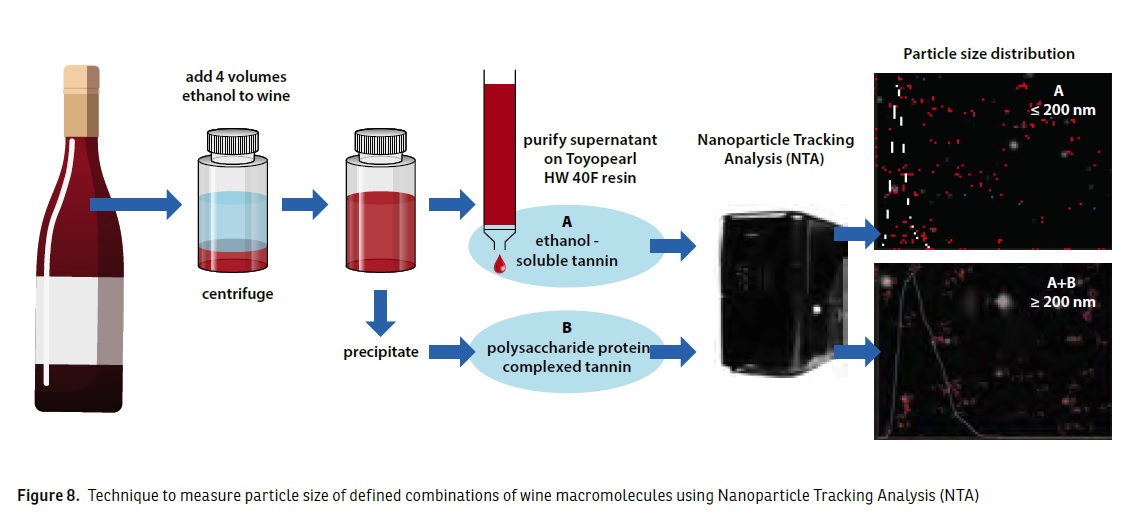
The effect of maceration was also studied in a large trial on Shiraz investigating the interactive effect of maceration time (7 and 30 days), macerating enzyme and yeast strains (high-tannin versus low-tannin). Macerating enzyme application decreased both polysaccharide and particle size and concentration, but only during short maceration times (7 days). Extending maceration facilitated increased extraction of tannin, and both grape and yeast polysaccharides, and under these conditions this particular enzyme application had a limited effect on wine composition. Particle size averages ranged from 130 to 160 nm, suggesting that the selected maceration techniques were unlikely to affect wine colloidal stability.
To better understand the impact of enzyme on macromolecule extraction and stability, a more in-depth study was performed using model fermentations and purified cell walls. A visiting scientist, Dr Federica Blando from the Institute of Sciences of Food Production in Lecce, Italy was involved with this project under an OECD fellowship grant. Enzyme application was found to increase tannin extraction primarily by a drastic deconstruction of the cell walls, leading to reduced total marc recovery by weight but interestingly, no increase in lees biomass. Model cell wall studies and wines made by PhD student Sijing Li (University of Adelaide) showed that this was because the enzyme increased polysaccharide concentration initially, but depolymerisation to sugars was ongoing, leading to a large release of galacturonic acid (from pectin) and reduced final polysaccharide concentration. Enzyme application reduced the ability of grape cell walls to adsorb tannin, but at the same time resulted in an increased release of protein from grape mesocarp (pulp) cell walls. This protein, although a minor component of the cell wall, could remove up to 50% of tannin from solution by the formation of unstable complexes. These complexes eventually precipitated, and were too large for an accurate size to be determined by NTA, but could be visualised by microscopy (Figure 9). This identified a potential mechanism by which extracted grape tannin may be lost from wine during vinification, theoretically proceeding until all protein (or all tannin) is removed from solution. This might explain why enzyme application does not always result in significant increases in tannin concentration.
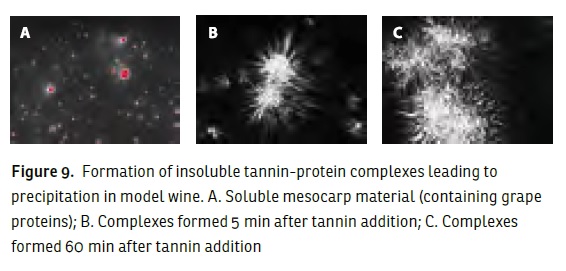
In the 2016 vintage, macerating enzyme application was explored further, along with addition of white marc as another way to modulate tannin during Shiraz maceration. Wines were made from two fruit parcels at different ripeness, achieving target alcohol levels of 11% (lower alcohol wine) and 14.6%. Investigation of the impacts of this experiment on a range of chemistry and sensory outcomes is under way.
Project Team
Markus Herderich
Paul Smith
Keren Bindon
Richard Gawel
Stella Kassara
Jacqui McRae
Agnieszka Mierczynska-Vasilev
References
Bindon, K.A., Carew, A.L., Mierczynska-Vasilev, A. Kassara, S., Kerslake, F., Smith, P.A. 2016a. Characterization of macromolecular complexes in red wine: Composition, molecular mass distribution and particle size. Food Chem. 199: 838-846.
Bindon, K.A., Kassara, Smith, P.A. 2016b. Toward a model of grape tannin extraction under wine-like conditions: the role of suspended mesocarp material and anthocyanin concentration. Aust. J. Grape Wine Res., in press.

